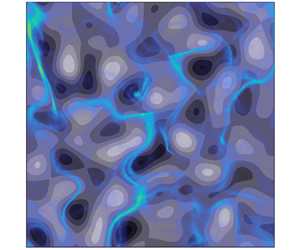Crossref Citations
This article has been cited by the following publications. This list is generated based on data provided by
Crossref.
Liu, Zehua
Jiang, Linfeng
and
Sun, Chao
2022.
Accumulation and alignment of elongated gyrotactic swimmers in turbulence.
Physics of Fluids,
Vol. 34,
Issue. 3,
Monthiller, Rémi
Loisy, Aurore
Koehl, Mimi A. R.
Favier, Benjamin
and
Eloy, Christophe
2022.
Surfing on Turbulence: A Strategy for Planktonic Navigation.
Physical Review Letters,
Vol. 129,
Issue. 6,
Zhao, Qingyi
Jin, Guodong
and
Zhou, Zhideng
2022.
Deep learning method for the super-resolution reconstruction of small-scale motions in large-eddy simulation.
AIP Advances,
Vol. 12,
Issue. 12,
Qiu, Jingran
Marchioli, Cristian
and
Zhao, Lihao
2022.
A review on gyrotactic swimmers in turbulent flows.
Acta Mechanica Sinica,
Vol. 38,
Issue. 8,
Xu, Ao
Wu, Hua-Lin
and
Xi, Heng-Dong
2022.
Migration of self-propelling agent in a turbulent environment with minimal energy consumption.
Physics of Fluids,
Vol. 34,
Issue. 3,
Zhu, Yi
Pang, Jian-Hua
and
Tian, Fang-Bao
2022.
Point-to-Point Navigation of a Fish-Like Swimmer in a Vortical Flow With Deep Reinforcement Learning.
Frontiers in Physics,
Vol. 10,
Issue. ,
Zhu, Guangpu
Fang, Wen-Zhen
and
Zhu, Lailai
2022.
Optimizing low-Reynolds-number predation via optimal control and reinforcement learning.
Journal of Fluid Mechanics,
Vol. 944,
Issue. ,
Redaelli, T.
Candelier, F.
Mehaddi, R.
and
Mehlig, B.
2022.
Unsteady and inertial dynamics of a small active particle in a fluid.
Physical Review Fluids,
Vol. 7,
Issue. 4,
Paz, Stevens
Ausas, Roberto F.
Carbajal, Juan P.
and
Buscaglia, Gustavo C.
2023.
Chemoreception and chemotaxis of a three-sphere swimmer.
Communications in Nonlinear Science and Numerical Simulation,
Vol. 117,
Issue. ,
p.
106909.
Xu, Ao
Wu, Hua-Lin
and
Xi, Heng-Dong
2023.
Long-distance migration with minimal energy consumption in a thermal turbulent environment.
Physical Review Fluids,
Vol. 8,
Issue. 2,
El Khiyati, Zakarya
Chesneaux, Raphaël
Giraldi, Laëtitia
and
Bec, Jérémie
2023.
Steering undulatory micro-swimmers in a fluid flow through reinforcement learning.
The European Physical Journal E,
Vol. 46,
Issue. 6,
Qin, Ke
Zou, Zonghao
Zhu, Lailai
and
Pak, On Shun
2023.
Reinforcement learning of a multi-link swimmer at low Reynolds numbers.
Physics of Fluids,
Vol. 35,
Issue. 3,
Fang, Wen‐Zhen
Xiong, Tongzhao
Pak, On Shun
and
Zhu, Lailai
2023.
Data‐Driven Intelligent Manipulation of Particles in Microfluidics.
Advanced Science,
Vol. 10,
Issue. 5,
Ventrella, F. M.
Pujara, N.
Boffetta, G.
Cencini, M.
Thiffeault, J.-L.
and
De Lillo, F.
2023.
Microswimmer trapping in surface waves with shear.
Proceedings of the Royal Society A: Mathematical, Physical and Engineering Sciences,
Vol. 479,
Issue. 2278,
Li, Bocheng
Qiu, Jingran
and
Zhao, Lihao
2023.
Feeding of planktotrophic squirmers: Effects of mobility and elongation of planktonic particles.
Physics of Fluids,
Vol. 35,
Issue. 12,
Sankaewtong, Krongtum
Molina, John J.
Turner, Matthew S.
and
Yamamoto, Ryoichi
2023.
Learning to swim efficiently in a nonuniform flow field.
Physical Review E,
Vol. 107,
Issue. 6,
Ruszczyk, Melissa
Webster, Donald R.
and
Yen, Jeannette
2024.
The response of a freshwater copepod to small‐scale, dissipative eddies in turbulence.
Limnology and Oceanography,
Vol. 69,
Issue. S1,
Xu, Ao
Wu, Hua-Lin
and
Xi, Heng-Dong
2024.
Proceedings of the IUTAM Symposium on Turbulent Structure and Particles-Turbulence Interaction.
Vol. 41,
Issue. ,
p.
313.
Sankaewtong, Krongtum
Molina, John J.
and
Yamamoto, Ryoichi
2024.
Efficient navigation of cargo-towing microswimmer in non-uniform flow fields.
Physical Review Research,
Vol. 6,
Issue. 3,
Sankaewtong, Krongtum
Molina, John J.
and
Yamamoto, Ryoichi
2024.
Autonomous navigation of smart microswimmers in non-uniform flow fields.
Physics of Fluids,
Vol. 36,
Issue. 4,




